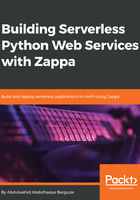
Creating a Lambda function
Here, we are going to create a new Lambda function with the aws lambda create-function command. To run this command, we need to pass the required and optional arguments.
Make sure you have a role with permission for the lambda:CreateFunction action.
Previously, in the AWS Lambda console, we chose the code entry point as inline editing. Now, we will be using a ZIP file as a deployment package.
Before creating the Lambda function, we should create a Lambda function deployment package.
This deployment package will be a ZIP file consisting of your code and any dependencies.
If your project has some dependencies, then you must install the dependencies in the root directive of the project. For example:
$ pip install requests -t <project-dir> OR $ pip install -r requirements.txt -t <project-dir>
Here, the -t option indicates the target directory.
Create a simple lambda_handler function in a file named as handler.py, as shown in the following screenshot:

Now, let's make a deployment package as a ZIP file consisting of the preceding code:

Now, we are ready to create the Lambda function. The following screenshot describes the command execution:

You can see that, in the AWS Lambda console, the Lambda function immediately got created:

Let's discuss the required and optional parameters that we used with the aws lambda create-function command:
- --function-name (required): The name is self-explanatory. We need to pass the Lambda function name that we are intending to create.
- --role (required): This is a required parameter where we need to use the AWS role ARN as a value. Make sure this role has permissions to create the Lambda function.
- --runtime (required): We need to mention the runtime environment for the Lambda function execution. As we mentioned earlier, AWS Lambda supports Python, Node.js, C#, and Java. So these are the possible values:
- python2.7
- python3.6
- nodejs
- nodejs4.3
- nodejs6.10
- nodejs4.3-edge
- dotnetcore1.0
- java8
- --handler (required): Here, we mention the function path that will be an execution entry point by the AWS Lambda. In our case, we used handler.lambda_function, where the handler is the file that contains the lambda_function.
- --description: This option lets you add some text description about your Lambda function.
- --zip-file: This option is used to upload the deployment package file of your code from your local environment/machine. Here, you need to add fileb:// as a prefix to your ZIP file path.
- --code: This option helps you upload the deployment package file from the AWS S3 bucket.
You should pass a string value with a pattern, such as the one shown here:
"S3Bucket=<bucket-name>,S3Key=<file-name>,S3ObjectVersion=<file-version-id>".
There are many other optional parameters available that you can see with the help command, such as aws lambda create-function help. You can use them as per your requirement.
Now we will see the Lambda function invocation using the command $ aws lambda invoke.